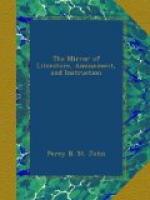It is said, however, that the use of cigars is beneficial when we find ourselves in marshy situations, with a high temperature, and generally, whenever the atmosphere inclines to the introduction of putridity and fever into the system. We believe this; and perhaps a useful theory of the alternate benefit and mischief of cigar-smoking may be offered upon the basis of that proposition. When and wherever the body requires to be dried, cigar-smoking may be salutary; and when and wherever that drying, or desiccation, is injurious, then and there cigar-smoking may be to be shunned. We know that, while surrounded by an atmosphere overcharged, or even only saturated with moisture, moist bodies remain moist, or do not part with that excess of moisture from which a drier atmosphere would relieve them; and that living bodies, so circumstanced, are threatened with typhus and typhoid fever. It is highly probable, therefore, that narcotics, in such cases, may allay a morbid irritability of the nerves, or effect a salutary diminution of healthful sensibility; under such circumstances, the desiccating and sedative effects of tobacco-smoking may prove beneficial; while, in all ordinary states of the system and of the atmosphere, the same desiccative and sedative influences may produce immediate evil consequences, more or less readily perceptible, and undermine, however gradually, the strength of the constitution.—United Service Journal.
* * * * *
THE NEW COINAGE.
Why does not some man of public research enlighten the public on the proceedings at the Mint? The whole system is as little comprehensible by the uninitiated as the philosopher’s stone. The cost of the Mint is prodigious—the machinery is all that machinery can be; yet we have one of the ugliest coinages of any nation of Europe. A new issue of coin is about to be commenced.
“It appears, from the king’s proclamation, that the new coinage will consist of double sovereigns, to be each of the value of 40s.; sovereigns, each of 20s.; and half-sovereigns, 10s. silver crowns, half-crowns, shillings, and sixpences. The double-sovereigns have for the obverse the king’s effigy, with the inscription, ’Gulielmus IIII. D.G. Britanniarum Rex. F.D.;’ and for the reverse, the ensigns armorial of the United Kingdom contained in a shield, encircled by the collar of the Order of the Garter, and upon the edge of the piece the words ’Decus et Tutamen.’ The crowns and half-crowns will be similar. The shilling has on the reverse the words ‘One Shilling,’ placed in the centre of the piece, within a wreath, having an olive-branch on one side, and an oak-branch on the other; and the sixpences have the same, except the word ‘Sixpence’ instead of the words ‘One Shilling.’ The coppers will be nearly as at present.”




